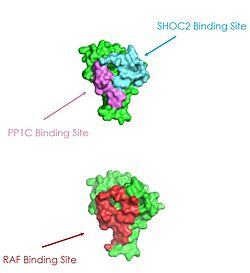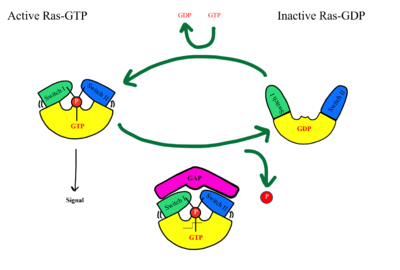Sandbox Reserved 1767
From Proteopedia
| Line 18: | Line 18: | ||
The Protein phosphatase complex 1 (PP1C) subunit contains the catalytic site of the SMP complex. The PP1C subunit is a phosphatase enzyme responsible for the removal of a phosphate group on the N-terminal phosphoserine (NTpS) of RAF (Ser259).<ref name="Liau">PMID: 35768504</ref>. The exact mechanism of dephosphorylation is currently unknown, but there are three catalytic metal ions: 2 Mn2+ and 1 Cl- present that coordinate nucleophilic water molecules in the active site. This dephosphorylation event allows for pathway activation. Although PP1C can dephosphorylate other proteins independently from the SMP complex, it cannot act on Raf unless bound to the complex because it lacks intrinsic substrate selectivity.<ref name="Liau">PMID: 35768504</ref> SHOC2 and MRAS aid in the specificity of the enzymatic activity. Hence, PP1C requires the presence of SHOC2 and MRAS to be function. <ref name="Hauseman">PMID:35830882</ref> PP1C binds to SHOC2 and MRAS-GTP in a specific orientation that doesn’t change the conformation of the catalytic site and leaves it accessible for substrate binding. | The Protein phosphatase complex 1 (PP1C) subunit contains the catalytic site of the SMP complex. The PP1C subunit is a phosphatase enzyme responsible for the removal of a phosphate group on the N-terminal phosphoserine (NTpS) of RAF (Ser259).<ref name="Liau">PMID: 35768504</ref>. The exact mechanism of dephosphorylation is currently unknown, but there are three catalytic metal ions: 2 Mn2+ and 1 Cl- present that coordinate nucleophilic water molecules in the active site. This dephosphorylation event allows for pathway activation. Although PP1C can dephosphorylate other proteins independently from the SMP complex, it cannot act on Raf unless bound to the complex because it lacks intrinsic substrate selectivity.<ref name="Liau">PMID: 35768504</ref> SHOC2 and MRAS aid in the specificity of the enzymatic activity. Hence, PP1C requires the presence of SHOC2 and MRAS to be function. <ref name="Hauseman">PMID:35830882</ref> PP1C binds to SHOC2 and MRAS-GTP in a specific orientation that doesn’t change the conformation of the catalytic site and leaves it accessible for substrate binding. | ||
PP1C binds to SHOC2 through a hydrophobic n-terminal disordered region that is complimentary to the RVXF motif on SHOC2. GREEN LINK or picture? Similarly to SHOC2, PP1C does not undergo a significant conformational change when SHOC2 and MRAS-GTP bind. The lack of conformational change shows that the structure of PP1C is not dependent on the SMP complex, but in order to act as a phosphatase it must be bound to the complex.<ref name="Liau">PMID: 35768504</ref>. | PP1C binds to SHOC2 through a hydrophobic n-terminal disordered region that is complimentary to the RVXF motif on SHOC2. GREEN LINK or picture? Similarly to SHOC2, PP1C does not undergo a significant conformational change when SHOC2 and MRAS-GTP bind. The lack of conformational change shows that the structure of PP1C is not dependent on the SMP complex, but in order to act as a phosphatase it must be bound to the complex.<ref name="Liau">PMID: 35768504</ref>. | ||
| - | PP1C binds to SHOC2 and MRAS-GTP in a specific orientation that | + | PP1C binds to SHOC2 and MRAS-GTP in a specific orientation that does not cause a change in the conformation of the catalytic site and leaves it accessible for substrate binding. '''GREEN LINK or picture?''' |
The substrate binds through hydrogen bonds with the main chain and side chain atoms of the catalytic residues **insert residue numbers here**. Mutations in the active site lead to increased activity, causing the Ras/Raf signaling cascade to be triggered more frequently.<ref name="Hurley">PMID: 17636256</ref> ***insert what residues are mutated and HOW it leads to more activity. | The substrate binds through hydrogen bonds with the main chain and side chain atoms of the catalytic residues **insert residue numbers here**. Mutations in the active site lead to increased activity, causing the Ras/Raf signaling cascade to be triggered more frequently.<ref name="Hurley">PMID: 17636256</ref> ***insert what residues are mutated and HOW it leads to more activity. | ||
Revision as of 15:30, 13 April 2023
| This Sandbox is Reserved from February 27 through August 31, 2023 for use in the course CH462 Biochemistry II taught by R. Jeremy Johnson at the Butler University, Indianapolis, USA. This reservation includes Sandbox Reserved 1765 through Sandbox Reserved 1795. |
To get started:
More help: Help:Editing |
Contents |
SHOC2-PP1C-MRAS
| |||||||||||
Protopedia Resources
References
- ↑ 1.0 1.1 1.2 1.3 1.4 1.5 Kwon JJ, Hajian B, Bian Y, Young LC, Amor AJ, Fuller JR, Fraley CV, Sykes AM, So J, Pan J, Baker L, Lee SJ, Wheeler DB, Mayhew DL, Persky NS, Yang X, Root DE, Barsotti AM, Stamford AW, Perry CK, Burgin A, McCormick F, Lemke CT, Hahn WC, Aguirre AJ. Structure-function analysis of the SHOC2-MRAS-PP1C holophosphatase complex. Nature. 2022 Jul 13. pii: 10.1038/s41586-022-04928-2. doi:, 10.1038/s41586-022-04928-2. PMID:35831509 doi:http://dx.doi.org/10.1038/s41586-022-04928-2
- ↑ 2.0 2.1 2.2 2.3 2.4 2.5 2.6 Hauseman ZJ, Fodor M, Dhembi A, Viscomi J, Egli D, Bleu M, Katz S, Park E, Jang DM, Porter KA, Meili F, Guo H, Kerr G, Molle S, Velez-Vega C, Beyer KS, Galli GG, Maira SM, Stams T, Clark K, Eck MJ, Tordella L, Thoma CR, King DA. Structure of the MRAS-SHOC2-PP1C phosphatase complex. Nature. 2022 Jul 13. pii: 10.1038/s41586-022-05086-1. doi:, 10.1038/s41586-022-05086-1. PMID:35830882 doi:http://dx.doi.org/10.1038/s41586-022-05086-1
- ↑ 3.00 3.01 3.02 3.03 3.04 3.05 3.06 3.07 3.08 3.09 3.10 3.11 3.12 3.13 Liau NPD, Johnson MC, Izadi S, Gerosa L, Hammel M, Bruning JM, Wendorff TJ, Phung W, Hymowitz SG, Sudhamsu J. Structural basis for SHOC2 modulation of RAS signalling. Nature. 2022 Jun 29. pii: 10.1038/s41586-022-04838-3. doi:, 10.1038/s41586-022-04838-3. PMID:35768504 doi:http://dx.doi.org/10.1038/s41586-022-04838-3
- ↑ Hurley TD, Yang J, Zhang L, Goodwin KD, Zou Q, Cortese M, Dunker AK, DePaoli-Roach AA. Structural basis for regulation of protein phosphatase 1 by inhibitor-2. J Biol Chem. 2007 Sep 28;282(39):28874-83. Epub 2007 Jul 18. PMID:17636256 doi:http://dx.doi.org/10.1074/jbc.M703472200
- ↑ 5.0 5.1 Young LC, Hartig N, Boned Del Río I, Sari S, Ringham-Terry B, Wainwright JR, Jones GG, McCormick F, Rodriguez-Viciana P. SHOC2-MRAS-PP1 complex positively regulates RAF activity and contributes to Noonan syndrome pathogenesis. Proc Natl Acad Sci U S A. 2018 Nov 6;115(45):E10576-E10585. PMID:30348783 doi:10.1073/pnas.1720352115
- ↑ Lavoie H, Therrien M. Structural keys unlock RAS-MAPK cellular signalling pathway. Nature. 2022 Sep;609(7926):248-249. PMID:35970881 doi:10.1038/d41586-022-02189-7
1. Hauseman ZJ, Fodor M, Dhembi A, Viscomi J, Egli D, Bleu M, Katz S, Park E, Jang DM, Porter KA, Meili F, Guo H, Kerr G, Mollé S, Velez-Vega C, Beyer KS, Galli GG, Maira SM, Stams T, Clark K, Eck MJ, Tordella L, Thoma CR, King DA. Structure of the MRAS-SHOC2-PP1C phosphatase complex. Nature. 2022 Sep;609(7926):416-423. doi: 10.1038/s41586-022-05086-1. Epub 2022 Jul 13. PMID: 35830882; PMCID: PMC9452295.[1].
2. Hurley TD, Yang J, Zhang L, Goodwin KD, Zou Q, Cortese M, Dunker AK, DePaoli-Roach AA. Structural basis for regulation of protein phosphatase 1 by inhibitor-2. J Biol Chem. 2007 Sep 28;282(39):28874-28883. doi: 10.1074/jbc.M703472200. Epub 2007 Jul 18. PMID: 17636256.[2].
3. Kwon JJ, Hajian B, Bian Y, Young LC, Amor AJ, Fuller JR, Fraley CV, Sykes AM, So J, Pan J, Baker L, Lee SJ, Wheeler DB, Mayhew DL, Persky NS, Yang X, Root DE, Barsotti AM, Stamford AW, Perry CK, Burgin A, McCormick F, Lemke CT, Hahn WC, Aguirre AJ. Structure-function analysis of the SHOC2-MRAS-PP1C holophosphatase complex. Nature. 2022 Sep;609(7926):408-415. doi: 10.1038/s41586-022-04928-2. Epub 2022 Jul 13. PMID: 35831509; PMCID: PMC9694338.[3].
4. Liau NPD, Johnson MC, Izadi S, Gerosa L, Hammel M, Bruning JM, Wendorff TJ, Phung W, Hymowitz SG, Sudhamsu J. Structural basis for SHOC2 modulation of RAS signalling. Nature. 2022 Sep;609(7926):400-407. doi: 10.1038/s41586-022-04838-3. Epub 2022 Jun 29. PMID: 35768504; PMCID: PMC9452301.[4].
5. Lavoie H, Therrien M. Structural keys unlock RAS-MAPK cellular signalling pathway. Nature. 2022 Sep;609(7926):248-249. doi: 10.1038/d41586-022-02189-7. PMID: 35970881.[5].
6. Young LC, Hartig N, Boned Del Río I, Sari S, Ringham-Terry B, Wainwright JR, Jones GG, McCormick F, Rodriguez-Viciana P. SHOC2-MRAS-PP1 complex positively regulates RAF activity and contributes to Noonan syndrome pathogenesis. Proc Natl Acad Sci U S A. 2018 Nov 6;115(45):E10576-E10585. doi: 10.1073/pnas.1720352115. Epub 2018 Oct 22. PMID: 30348783; PMCID: PMC6233131.[6].
Student Contributors
- Sloan August
- Rosa Trippel
- Kayla Wilhoite



